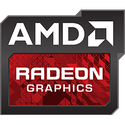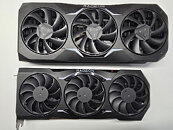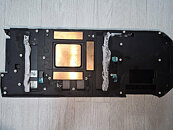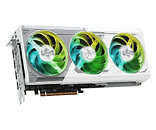
Unreleased AMD Radeon "RX 7950 XTX" Prototype Surfaces Online
A previously unseen AMD graphics-card prototype has unexpectedly surfaced, not in a retailer's warehouse but on a Korean second-hand forum. This week, a Quasarzone user known as FP32 shared high-resolution photographs of what appears to be the cooling assembly for a never-released "RX 7950 XTX," allegedly sourced via China's Xianyu marketplace. At a staggering 34 cm in length and 5.5 cm in thickness, the triple-slot shroud outstrips the standard RX 7900 XTX reference cooler by roughly 5 cm in length and adds an entire slot of girth. The front houses three recessed eight-pin power connectors, suggesting board power well over 450 W, a figure more commonly associated with NVIDIA's RTX 4090 rather than an AMD Radeon, while a dense copper baseplate feeds multiple heatpipes that terminate in three striking red-tipped fins stamped "RDNA 3." Despite its superficial resemblance to AMD's shipping designs, the prototype's mounting points and LED cut-outs align with no known PCB, and the customary rear I/O bracket is entirely missing.
Attempts to trace serial labels in public component databases yielded no matches, reinforcing the theory that it was a one-off engineering sample. No PCB accompanied the cooler, preventing any live demonstrations or performance benchmarks. There have long been whispers about an AMD halo card, whether an RX 7950 XTX or even a dual-GPU RX 7990 XTX, to bridge the performance gap between NVIDIA's 80-class and 90-class offerings. The emergence of this monolithic cooler implies that AMD once considered a fully unlocked Navi 31 silicon pushed to higher clock speeds or paired with faster GDDR6/GDDR6X memory. The project may have been shelved due to soaring production costs, unwieldy thermal envelopes, or a strategic decision to focus on energy efficiency and value-oriented designs. Whatever the reason for its cancellation, this orphaned cooler now stands as a relic of AMD's road not taken, offering a glimpse into the company's highest ambitions before it chose a less aggressive path for its RDNA 3 lineup.
Attempts to trace serial labels in public component databases yielded no matches, reinforcing the theory that it was a one-off engineering sample. No PCB accompanied the cooler, preventing any live demonstrations or performance benchmarks. There have long been whispers about an AMD halo card, whether an RX 7950 XTX or even a dual-GPU RX 7990 XTX, to bridge the performance gap between NVIDIA's 80-class and 90-class offerings. The emergence of this monolithic cooler implies that AMD once considered a fully unlocked Navi 31 silicon pushed to higher clock speeds or paired with faster GDDR6/GDDR6X memory. The project may have been shelved due to soaring production costs, unwieldy thermal envelopes, or a strategic decision to focus on energy efficiency and value-oriented designs. Whatever the reason for its cancellation, this orphaned cooler now stands as a relic of AMD's road not taken, offering a glimpse into the company's highest ambitions before it chose a less aggressive path for its RDNA 3 lineup.














































































